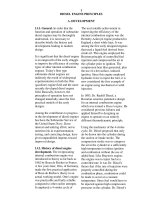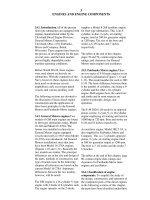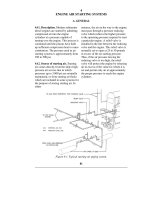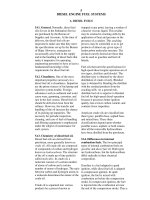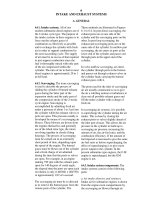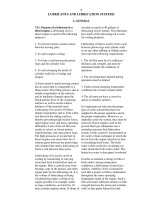Tài liệu Tài liệu Diezel 1410 P11 pptx
Bạn đang xem bản rút gọn của tài liệu. Xem và tải ngay bản đầy đủ của tài liệu tại đây (368.12 KB, 16 trang )
11
JOURNALS, BEARINGS, AND ALIGNMENT
A. GENERAL
11A1. General. The operator of any
piece of machinery should thoroughly
understand the various adjustments that
are necessary for perfect operation. It is
not enough for him to know merely
which valve to open and close or the
position of maneuvering levers in order
to start, stop, and reverse his machine.
He must possess knowledge of the
functioning of each of its systems when
he manipulates this gear. He should be
alert to note the difference between
efficient and poor performance by the
sound, smell, and touch of the
machinery. Instruments, such as gages,
thermometers, and tachometers,
however, should be the guides that the
operator uses in detecting the approach
of trouble so as to take corrective
measures before anything serious
occurs.
The modern diesel engine demands
greater skill on the part of the designer
and builder than any other kind of
engine. Likewise in its operation it is
far from being foolproof and requires
intelligent attention. The adjustments
are precise and to narrow limits.
Overhaul and fitting of the pistons,
rings, bearings, valves and fuel pumps
are beyond the capacity of the ordinary
machinist and demand the efforts of a
skilled mechanic. If it is properly
adjusted, a diesel engine, once started,
will run until it is stopped. The extent
of its reliability over a long period of
operation depends upon the intelligence
and skill of its operator.
Care must be used when operating oil
engines of any make, regardless of
whether the engine is of the 2- or 4-
stroke cycle, vertical or horizontal, air
or mechanical injection. The working
principles are the same, and the same
care must be exerted to have everything
properly adjusted before starting or
operating the engine. Otherwise, there
may be trouble. Every bearing should
sixty-fourths and thirty-seconds of an
inch are not recognized in diesel engine
work; the increment of measure for
everything is thousandths of an inch.
There should be a regular routine for
checking the different systems of the
engine and performing upkeep functions.
At this time all indications of wear, parts
renewed, and adjustments made should
be recorded in a systematic log book to
be used as a history from which
information may be obtained at future
overhaul periods. This is always done
during submarine refit periods and at any
other time when it is found necessary.
11A2. Construction of bearings. The
method used in construction of a bearing
depends upon the type, the bearing
metals to be used, and the type of use
required. In the case of precision type
bearings, it is necessary that the two
halves form a true circle when finished.
This requires rather ingenious practice,
and shop procedures will vary.
Other than the shop procedure, there are
only a few items concerning the
construction of bearings that are worthy
of mention. The first of these is the
question of oil grooves. Bearing
lubrication in the 2-stroke cycle engine is
more difficult than in the 4-stroke cycle
engine, since in the latter, the point of
contact between bearing and journals of
both main and crankpin journals rotates
around the bearing and assists in the
distribution of the oil. In the 2-stroke
cycle engine, the point of contact swings
back and forth across the lower bearing
shell and hence, in this engine, it is
usually necessary to provide oil grooves
on the unloaded side to carry sufficient
oil to the loaded half of the bearing.
Where bronze or other flat bearings are
used as wrist pins, ample grooving must
be provided. Grooves may be cut axially,
circumferentially, diagonally, or helically
across the face of the bearing, but should
be adjusted as tightly as possible. This
is a task for the real mechanic and
should not be entrusted to unskilled
personnel. The upkeep of the engine is
an important duty, and one in which the
real engineer shows his value. It should
be kept in mind that measurements of
never extend to the edge since this would
allow the oil to spill from the bearing. All
grooves should have rounded
216
edges, as the sharp edge of a groove has
a tendency to act as a scraper and may
impair the oil film.
In order that the flow of oil between the
bearing halves may not be restricted,
bearings are beveled for an arc of about
20 degrees at the joints where the
bearing halves come together, except
for a narrow strip at the ends, where the
full thickness of the metal must be
retained to prevent the loss of oil. The
spaces formed by beveling are called
oil cellars.
11A3. Bearing loads. The only
bearings in a diesel engine that require
careful consideration due to the heavy
loads placed upon them are the main,
crankpin, and wrist pin bearings. Other
bearings are not so limited in size, and
little attention need be given them in so
far as their ability to carry the load is
concerned. The following discussion
pertains principally to the above three
heavily loaded bearings that are usually
limited in size by the space available.
The study of bearing loading brings
two things to mind: 1) the temperature
at which the bearing must operate, and
2) the maximum pressure per unit area
that will be exerted upon the bearing.
Too much pressure will squeeze out the
oil film and ruin the bearing, and too
much heat will reduce the viscosity of
the oil until the film can no longer be
maintained. Both of these are factors of
loading, although the latter is a product
of loading and speed of rotation.
In a diesel engine operating at variable
loads, the successful bearing design is
generally the result of experimentation
directed toward the discovery of a
surfaces may make physical contact and
rupture the oil film.
From the above, it is obvious that an oil
film must be maintained at all times in
order to carry the load. This condition is
called stable lubrication. When the oil
film is destroyed and lubrication of the
bearing depends entirely upon the
oiliness of the lubricant, we have what is
known as unstable lubrication. This latter
condition exists when the bearing shaft is
running at too low a speed to build up an
oil film or when the bearing is
overloaded.
11A4. Bearing metals. Compared with
the journal, the bearing metal should be
sufficiently soft so that any solid matter
passing through in the oil stream will
wear the bearing instead of the journal.
Roller and ball bearings are frequently
used in diesel engines for smaller shafts,
such as camshafts, and in governors,
because they greatly reduce the bearing
friction and because their smaller
clearances keep the shaft more rigid. In at
least one opposed piston type of diesel
engine of medium power, ball bearings
are used as main bearings. For wrist pins,
roller bearings of the needle type are
used extensively in other types of large
engines. With these bearings, lubrication
is made simpler, and the amount of
freedom of motion and friction is
reduced.
Wood is used in the tail shaft bearings of
naval vessels that are submerged in water
and constantly lubricated and cooled.
Lignum vitae is the wood commonly
used for this purpose since it is of a
greasy character and extremely hard and
dense. Other types of materials used for
satisfactory bearing for all loads. The
loads that a bearing can withstand are
based upon the assumption that the
surfaces of the journal and bearing are
smooth and parallel, that proper
clearances are provided, and that
sufficient lubrication is provided. Too
much oil clearance at the ends of a
bearing will cause excessive oil leakage
and subsequent reduction in load-
carrying ability. If the bearing were
closed at the ends, the pressure would
be uniform over its entire length, and
much greater loads could be carried. If
the shafting is of in alignment, or
vibrates severely, as when running at a
critical speed, the faces of the journal
and bearing will not be parallel, and the
metallic
this purpose include hard rubber strips
and phenolic resinous materials.
Bronze bearings are used where the
pressures are very high such as at the
wrist pin. Here the load on the bearing is
the total gas pressure less the inertia of
the piston. In most modern diesel
engines, bronze is used as the bearing
metal for the wrist pin bearing.
There is no material known that is
suitable for all types of bearings. There
are four general types of alloys used
today but each has its own particular uses
determined by the maximum unit
pressure and temperature at which the
217
bearing will operate, and by the
hardness of the journal.
Bearing metals should be of such
composition that the coefficient of
friction is low. They should be
sufficiently hard and strong to carry the
load, but must not be brittle. If they are
too soft, they will wipe or be pounded
out, destroying the clearance and
reducing the bearing area. In grooved
bearings the grooves will become filled
with wiped metal. When this trouble
arises the oil film is squeezed out, the
metal is burned, and failure results.
The four commonly used types of
bearing linings are: high-lead babbitts,
tin-base babbitts, cadmium alloys, and
copper-lead mixtures.
The backs for bearings are made either
of steel or bronze in the case of the
babbitts, while only steel backs are
used for cadmium alloy and copper-
lead bearings. In some bearings, an
intermediate layer of metal is used
between the backs and the bearing
metals.
The hardness of the above bearing
metals naturally varies with the
percentage of alloying employed. In
shells are either forged or cast, and the
linings are made of lead-base babbitt
metal.
In the naval service the most frequently
encountered bearing metal used in
precision bearings is that known by the
trade name of Satco. The composition of
this metal is as follows:
Percent
Calcium .30- .70
Mercury .40- .90
Tin 1.00-2.00
Aluminum .15- .17
Magnesium 0.00- .05
Lead Remainder
11A5. Bearing installation and
adjustment. In order to insure its
successful operation, the bearing must fit
the journal perfectly; the bearing and
journal surfaces must be smooth and
parallel, and the bearing clearance must
be correct. Too great a clearance will
allow the oil to spill out at the ends of the
bearing, while too small a clearance will
cause the bearing to run hot. In general,
the least clearance that will allow the
successful operation of the bearing is
desirable.
general, however, the copper-lead and
cadmium alloys are the hardest, while
the high-lead and tin-base babbitts are
the softest. The temperature at which
the bearing metals melt is a rough
measure of their degree of hardness, the
softer metals melting at the lower
temperatures. The softness of the
bearing metal is also a measure of the
maximum allowable unit pressure. The
harder the bearing metal, the greater is
the load that a given size bearing will
carry without failure.
Where two metallic surfaces are
moving in contact with each other, such
as a journal rotating within a bearing,
wear will inevitably take place. Since it
is easier and cheaper to renew the
bearing, the journal should "be harder
than the bearing. Therefore, when using
relatively hard bearing metals, such as
cadmium alloy and copper-lead, it is
necessary to use a hard alloy steel
journal or else to harden the surface of
the journal.
The precision type of bearing is rapidly
coming into universal use for crankpin
and main bearings. There is an
increasing use of very thin bearing
linings on steel shells. The
In the modern high-speed engine the
precision type of bearing is generally
used. No scraping-in is done, and no
shims are used between the faces of the
two halves. The bearing is accurately
machined to the correct diameter and the
only fitting necessary is an occasional
filing down of the faces of the two halves
in order to obtain a close and even fit
when the bearing caps are brought
together. In connection with the fitting of
precision type bearings, too much
emphasis cannot be placed upon the
importance of having the backs of the
bearing shells fit evenly against the
bearing support. Recent experience with
bearing failures due to this improper
fitting has shown its importance. The
areas not in contact fill with oil or air,
both of which are relatively poor
conductors of heat, and the transfer of
heat from the bearing is reduced, causing
the bearing temperature to increase. In
addition, if an even fit is not obtained, a
flexing of the bearing shell may result,
causing the bearing metal to crack and
flake off.
218
To assure an even fit the backs of
bearings should be fitted to their
supports in the same manner that the
bearings are fitted to the journal. Since
the back usually is made of steel, it is
necessary to file down the high spots
rather than scrape them down as is
possible with softer bearing metals.
11A6. Bearing failures. When an
engine bearing fails in service it can
generally be attributed to one or more
of the following causes:
1. Poor operating conditions and
improper maintenance such as:
a. Improper or insufficient lubrication.
the bearing should be examined at once.
Also the lubricating oil gage pressure to
the system and the passage of cooling
water through the oil cooler should be
checked. Sometimes the overheating may
be due to foreign matter in the lubricating
oil. The oil should be rubbed between the
fingers to detect the presence of grit or
dirt. An inspection of the filters will also
reveal any abnormal amount of foreign
matter deposited there. Since used oil
generally is slightly acid, the presence of
salt water may be detected by inserting a
strip of red litmus paper in a sample of
the oil. If salt is present to any degree,
the litmus paper will turn blue. If salt
water is detected in the oil, the crankcase
and sump tank should be drained and
refilled with new oil after flushing the
system thoroughly. If possible, the cause
b. Insufficient cooling water.
c. Grit or dirt in oil.
d. Water in oil.
e. Bearings out of alignment.
f. Installing the bearing with improper
clearances or uneven bearing surface.
g. Excessive load on the bearing.
2. Faulty design of the bearing or of the
engine itself.
a. Improper dimensions of length and
diameter.
b. Improper bearing material.
c. Improper lubrication. The lubricant,
free from all foreign matter, must be
supplied in ample amounts.
d. Improperly cooled.
e. Improperly grooved.
f. Improperly baffled. Proper baffles
must be fitted to prevent loss of oil, or
its passage to adjacent parts of
machinery, such as generator armature,
where damage would result to the
commutator. Also in some cases baffles
are used to prevent the mixing of water
with the lubricating oil.
3. The use of inferior lubricants, or the
use of a good lubricant which does not
meet the requirements of the piece of
machinery.
a. Corrosion of bearings.
4. Inferior workmanship and material in
the manufacture of the bearings and
engine parts.
A bearing that is not operating properly
will overheat. When this occurs, and
the reason is not immediately known,
the oil supply to
of the salt water in the system should be
determined. At the first opportunity the
system should be well cleaned to remove
any particles of salt that may have been
deposited there.
As a rule, hot bearings may be traced to
one or more of the following causes:
1. Improper or insufficient lubrication.
2. Grit or dirt in the oil.
3. Bearings out of line.
4. Bearings set up too tightly.
5. Uneven surface of bearing or journal.
6. Bearing overloaded.
If the temperature of the bearing
continues to rise after the oil supply has
been increased, the condition known as a
hot bearing arises. The danger of a hot
bearing lies in the fact that the babbitt
expands until it grips the journal, thus
causing a constant increase in friction
and heat. When the temperature reaches
the melting point of the bearing metal,
the metal will run or wipe.
The treatment of heated bearings
involves two main items: the removal of
the cause, and the restoration of the
bearing to its normal condition. If the
trouble is due to improper or insufficient
lubrication and is discovered before the
metal has wiped, an abundant supply of
oil usually will be sufficient to control
the situation and gradually bring the
bearing back to its normal temperature.
Should the trouble be caused by an
accumulation of dirt on the bearing, the
abundant supply of oil will generally
flush out
219
the impurities sufficiently to permit
operation.
If the trouble is caused by foreign
matter in the oil, the oil will have to be
renovated or renewed. If the bearings
are out of alignment, if they are set up
too tightly, or if they have been
improperly fitted, the fault cannot be
fully remedied until the improper
adjustments have been rectified. This
usually involves stopping the engine.
In all cases the temperature of the
bearing can be lowered by slowing
down and thus decreasing the amount
of load on the bearing. If the trouble
has reached an advanced stage, it may
be found necessary to stop the engine.
When stopped, the bearing cap can be
eased up a slight amount, thus
increasing the clearance between the
bearing and journal. However, the
greatest care must be exercised in
easing up on the bearing cap, for if too
great a clearance is given, trouble will
be experienced from pounding.
When the trouble is inherent in the
bearing -as for example, if the
machinery is not properly lined up, or
the bearings are of insufficient area, or
not in proper condition-only temporary
relief can be secured from using the
various means suggested above. The
most effective treatment of a hot
bearing is probably the operation of the
machinery at a low or moderate power
until such time as the needed
readjustments, changes, or repairs can
be effected.
To summarize the treatment for a hot
bearing, the measures to be taken may
be selected according to the special
circumstances, from the following:
1. Lubrication.
2. Slowing down, and consequent
reduction of load, or stopping.
3. Cooling water to oil cooler.
condition can become serious enough to
cause bearing failures, and the only
remedy is to machine or grind down the
journal until it is again cylindrical. This,
of course, will reduce the diameter and
necessitate using a bearing of a different
bore in order to effect the proper bearing
clearances.
Journals should be kept smooth, even,
and free of rust at all times. To remove
spots of rust or ridges, the journal should
be dressed with a fine file and then
lapped with an oilstone or with an
oilstone powder. Carborundum may also
be used. If Carborundum is used, great
care must be taken to remove all
particles, as these, if allowed to remain,
will cause cutting and grinding of
bearings.
When bearings have been removed for
long periods, such as during a major
overhaul, it is customary to wrap the
journals with canvas in order to protect
them from accidental damage. When this
is done, only new canvas should be used.
There have been cases where journals
were wrapped with old rags or burlap
that contained some acid. The action of
this acid corroded and pitted the journals
and it was found necessary to renew the
entire shaft.
Each time a bearing is removed for any
reason the journal should be carefully
inspected. Any evidence of pitting or
general corrosion indicates the presence
of acid or water, and the lubricating oil
should be analyzed immediately. When a
bearing clearance exceeds the allowable
tolerance, or when the bearing fails due
to scoring, wiping, spalling, or cracking,
looseness of the bearing metal, or for any
other reason, it must be renewed.
To renew a precision type bearing it is
first necessary to have available a spare
bearing. These are manufactured to size
and are available from the manufacturer.
They are bored to correct dimensions, so
that only a slight amount of scraping in
and filing of the edges of the shell faces
is required to produce an accurate fit.
